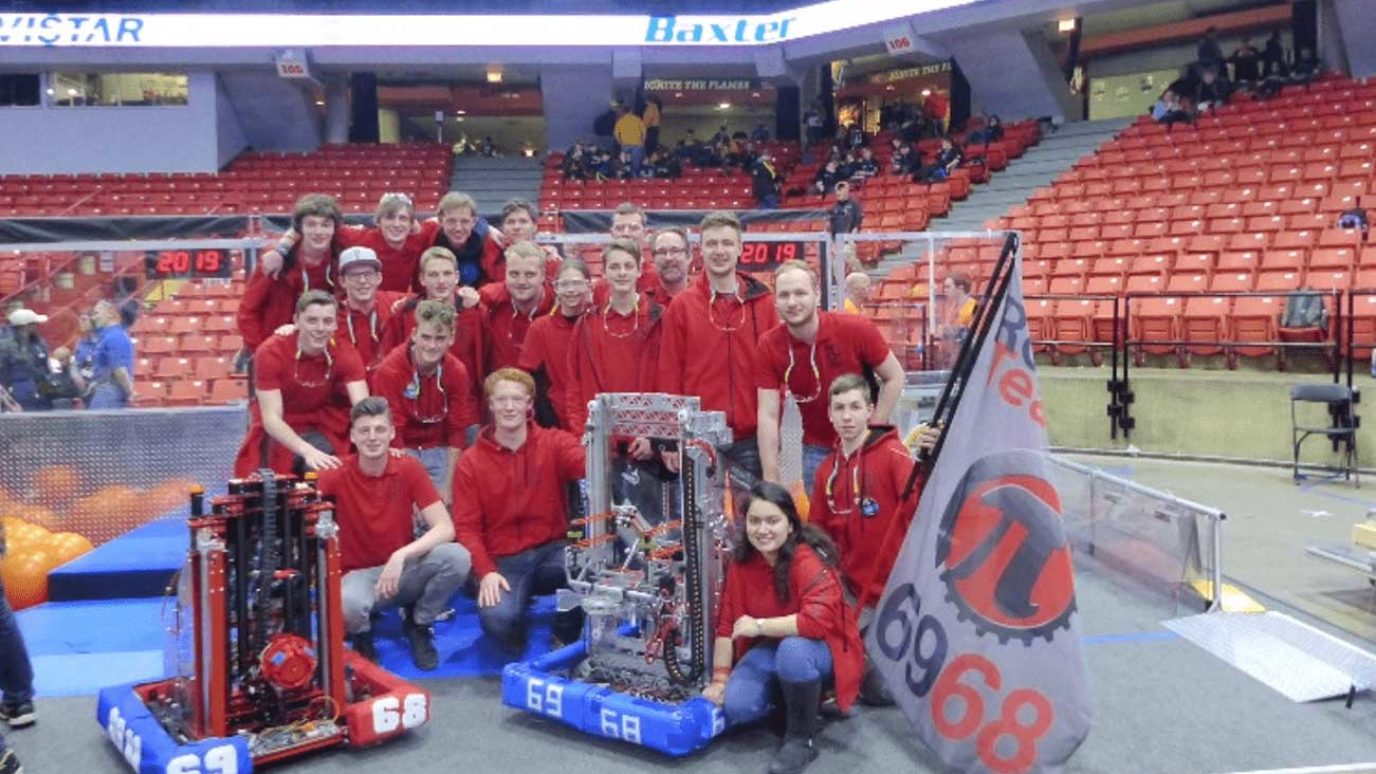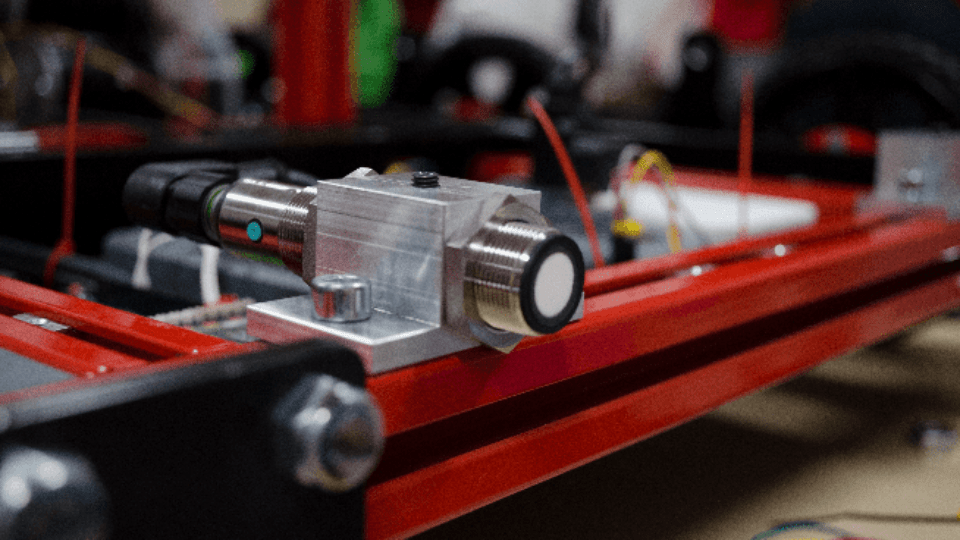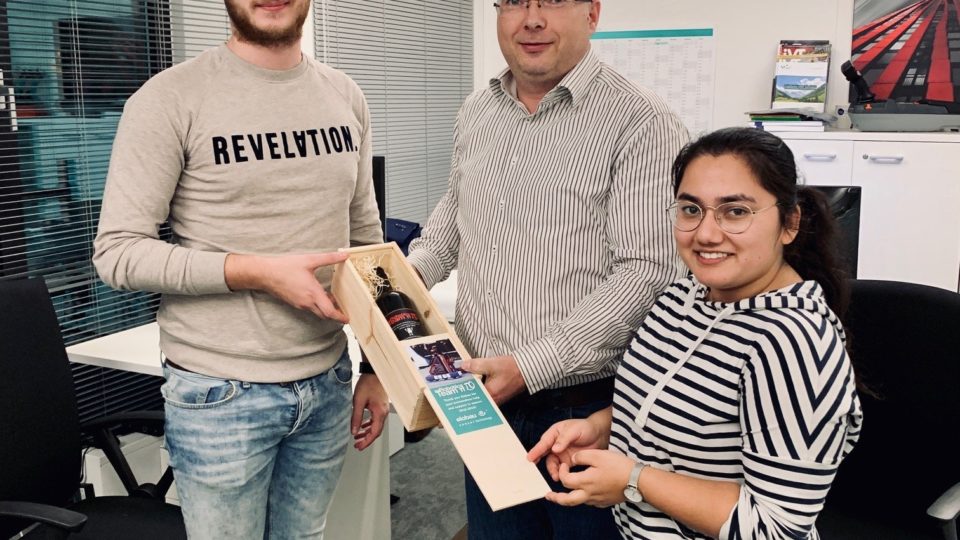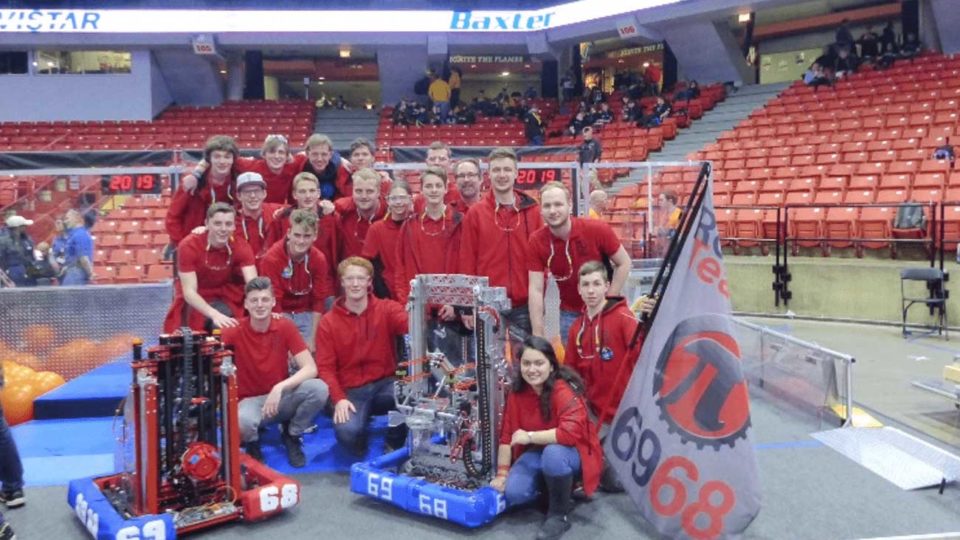

The Netherlands and its industry have already progressed so far with technological developments, but our education system is still very traditional. We all know that children learn better through play, but instead of letting them learn through practice, we continue to teach them theoretical truths from schoolbooks.
STEMec ™ Foundation
The STEMec ™ Foundation is our growing technology foundation that is committed to more technology in secondary education. For this, we use an American robotics competition called the FIRST Robotics Competition (FRC). For this robotics competition, students between 14 and 18 years old are challenged to develop a complex robot for an annual game, where the requirements change year over year.
In the Netherlands, however, we see that secondary school students of this age do not have sufficient knowledge to develop this robot. They often only come into contact with technology when they study it themselves. With our own robotics team—Robotics Team πwe want to change this by linking secondary education to the university through the profile paper. This way, students learn more about technology earlier and can, therefore, prepare themselves for further studying sooner rather than later.
FIRST Robotics Competition
Combining the excitement of sport with the rigours of science and technology.
We call the FIRST Robotics Competition, the ultimate sport for the mind. High-school student participants call it, “the hardest fun you’ll ever have.” Under strict rules with limited time and resources, teams of students are challenged to raise funds, design a team “brand,” hone teamwork, skills and build and program industrial-size robots to play a difficult field game against like-minded competitors. It’s as close to real-world engineering as a student can get. Volunteer professional mentors lend their time and talents to guide each team. Each season ends with an exciting FIRST Championship.
The growth of passion
When studying mechatronics at Fontys Hogescholen, students are required to do a project every quarter. In the first year of school, they all do the same project given by the school, but in the second year, students get to choose what they want to do from the range of projects. Within the school, there is a teacher who is very active and enthusiastic about the FRC. In 2016 the same teacher asked us if we were interested in starting a new team, so, Robotics Team π was first founded by seven mechatronics students. Together we got to know the FIRST organisation. We built a test robot called Primus—which means first in Latin—and chose and registered the name and colour of the team. During our first year of the project, our focus was only on building our robot. After the first year, four of the seven original students decided not to continue with Team π.
We, Willem Reuser / Anita Karki / Ivan Spikmans, have decided to continue with the team—with passion—to further develop our vision.
The first step of that vision was to broaden the skillset in the team. Therefore, in the 2017-2018 school year, the team welcomed in not only new members from mechatronics but also from mechanical engineering and electrical engineering. The team also started the first collaboration with a secondary school where it received nine students for their profile assignment. As a result, the team had a total of twenty-five members for the new school year. With this team, we built a robot and participated in the championships in the USA. Our team even won the Rookie All-Star award that year, which was the highest possible prize that we could win in our first year. This win gave us a place at the world championships.
Of course, it did not stop there, and with that success in mind, we were able to grow our team again with new members in the 2018-2019 school year, where the existing members stayed on to mentor the new ones. In total, the team reached thirty-five members with the Fontys students being added to the high school students.


The satisfaction and pride are immense
You don’t just build a robot, it requires proper preparation. That is precisely what we do in the first half of the year until the Christmas holiday, preparing ourselves for the coming season, which always starts the first weekend of January. From that weekend, there are six—hectic—weeks to design, model, build and test a robot. That Robot needs to be completed within the specifications and guidelines given to every contender by FIRST. There is no option to start sooner because you simply don’t know what to build. In short, you get practically no time to think carefully about something where quick decisions have to be made, and improvisation is a must. However, the satisfaction and pride you get from the final robot are immense. Seeing an idea formed into a robot is not only a complex process, but it is also very cool to experience.
The process of building the robot, travelling to the USA, and having our robot shipped there is also a costly venture. Many partners make it possible for us to be able to experience this wonderful moment. This comes from financial support to material support or even a combination of the two. This includes our proud partner, elobau. With the help of their ultrasonic sensors, our robot can position itself autonomously in front of the goal by using smart software that has been written by our own team members, which makes it possible for us to score points. Other partners make it possible for our robot to be ready in time, for example, by producing all semi-finished products. Everything we use must have been designed, engineered, and done by our team members themselves.
The blessing of the CEO of FIRST
Travelling to America is absolutely an adventure in and of itself—let alone being responsible for a large group of students—but it is always a very fun and educational experience. This year, our final destination was in ice-cold Chicago, where the temperature was -28 ° C (-18 Fahrenheit)! During our trip, we also tried to see some of the area. One reason for us to choose Chicago this year (as we are free to choose from different regionals) was that one of our partners, elobau, also has an office there, and we thought it would be a good experience to visit.
We were very fortunate to be able to spend a day in elobau’s office. There we were shown a company presentation from elobau, and we also showed and shared our adventure from the initial assignment to the trip to the USA. elobau also showed us a number of their products in their offices during the tour, and we concluded the visit with a joint lunch. Our thanks go to Francois Mortier and the entire elobau USA team for their hospitality and the warm welcome at their offices.
A regional is a preliminary round for the world championships where about fifty to sixty teams compete to get through the group stage. There is, of course, a bit of a rivalry, but the atmosphere is very pleasant. Every team is ready to help each other, and it doesn’t matter where you come from. For example, it is not permitted for us to ship batteries to the USA, so we have to borrow these from the other teams present at the competition, and at the end of the competition, we have more batteries than many American teams. We then, of course, show our gratitude to these teams by donating our delicious Dutch ‘stroopwafels.’
We needed that help a lot this year. Our robot did not come through customs as quickly as we wanted and needed, and unfortunately, it was not delivered to the competition site and was not in our possession until after the second day of the four-day competition. Another local team immediately offered us their help and drove for an hour and a half back to their workplace to collect their test robot. With that, we also received permission from the CEO of FIRST to play the competition with their test robot until we received our own robot. When our robot finally reached the building, we felt an immediate relief, and we too could proudly present our robot. At the time, our pit was by far the most visited pit of the competition with at least fifty people, watching us unpacking our robot. Our robot was then also chosen to play in the quarter-finals, and with that, we achieved a new milestone in our short history. That is why we can still look back at a successful regional for Robotics Team π.
To Conclude
We want to thank all the partners involved. Without their support and belief in our vision and goal, we would not be able to succeed. Unfortunately, it is not possible to list all of our partners, but you can view them on www.stemec.nl/partners. We especially want to thank Christian van Os of elobau Benelux for the valuable opportunity to share our story with the world.

Are you now thinking yourself, hey, this is really a cool project, and I want to know more about it or even contribute to it? Don’t hesitate to contact us via info@stemec.nl !
For more information about elobau´s ultrasonic sensors, please visit https://www.ultrasonicsensors.world/en/

Comments
write a comment